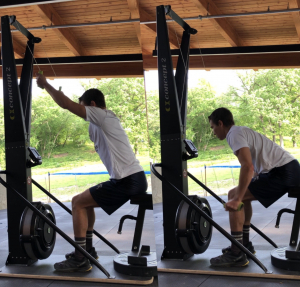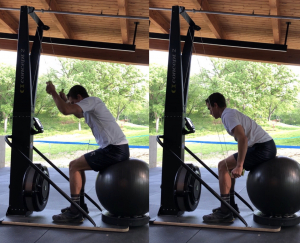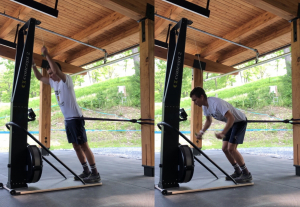SkiErg for genoptræning
Udgivet: 17. jun 2019 af: Reiner

I love movement and exercise, and if you're reading this then chances are you enjoy a healthy dose of movement as well. We rely on our bodies as vehicles for movement and they usually deliver, allowing us collectively to do some amazing things. Sometimes, however, bodies break down and we get injured. And when that happens it can be an incredibly frustrating thing, especially when it prevents us from moving in the way we are used to and from doing the things we love.
In this blog I will share my experience using the Concept2 SkiErg while recovering from two surgeries: one to repair a broken left fibula and one to trim a torn right meniscus. Please note that this is my experience and only that. It is not medical advice. If you are injured, it's very important to consult with your doctor about what activities you are permitted to do, and how much you can do, before reintroducing training or exercise. I have found it additionally helpful to work with a physical therapist on a regular basis, not only for the PT but also to receive frequent professional input when discussing how to safely progress my training.

Early on in my recovery I wasn't able to stand on both legs, let alone load or create any significant force with either of them. This ruled out most training modalities. No running, no roller skiing, no biking, and no swimming. After I got over the initial frustration of not being able to do these activities, I turned to the SkiErg. I was lucky that my dad had a SkiErg in the basement. He pulled a bench up to it for me, and I set my crutches to the side and began experimenting with seated SkiErg techniques and position. I soon discovered that I could get a darn good workout while seated. Although the seated technique is slightly different from standing because the hips are fixed in space, the muscle activation chain is similar--hip flexors, core, and arms are all active. Even the quads work to keep the body from being pulled forward off the bench. I found it surprisingly easy to keep my heart rate elevated; during intervals my heart rate while sitting was only ~5 beats lower than while standing.

After a few sessions on the seated SkiErg, I was sore! It was that kind of soreness that makes you excited about getting stronger, a sign that you're really doing something. Surprising though it may seem, a part of me was excited to be focusing solely on upper body training for six weeks. It's not something I'd done before, and I was curious to see how my body would respond to six weeks filled only with SkiErg, flatwater paddling, upper-body strength training and lower-body PT exercises. I did get sore (despite keeping the SkiErg damper at its easiest setting), but I found a good rhythm that balanced hard training with recovery of SkiErg specific muscle groups. For me, this was four days of SkiErg followed by two days of paddling and a day off. I tend to find that a few days of concentrated training followed by a couple days of active rest work better than alternating days, but you may find that a different rhythm works best for you.

The SkiErg also allowed me to make a calculated transition from seated to standing erg. With the approval of my doctor I started with just a few easy minutes of standing SkiErg during a seated training session. I then increased the proportion of my workout spent in the standing position over the course of two weeks. This is a huge benefit to using the erg when returning from injury: if you get sore or things just don't feel quite right, you can return to seated erg as needed.
Interested in trying out seated SkiErg? Setting up the seated position can get a little tricky. Here are some suggestions:
- Sit on the short end of a narrow bench. Your hands won't hit the bench as you follow through with the handles.
- Sit as far forward on the bench as possible. This encourages good posture and technique that more closely resembles the standing double pole.
- Consider putting a thick plate under the bench to raise the system. This will help you complete the full upper body motion without being cut short by the cord length.
- It may be helpful to set up a mirror on one side for your first erg session or two. This helped me to make sure I was ingraining good technical habits: flat back, reaching up and forward with the arms, and keeping the shoulders relaxed.
- If you can't bend your knee, rest your foot on a block to allow the leg to remain straight.
Want to introduce more variety into your SkiErg workouts? Here are some ideas:
- Sit on an inflatable ball: Your core will work to deal with the added instability, and the ball will allow your hips some travel.
- Use a band while standing: Connect an elastic band between your waist and a fixed point behind you. This will allow you for forward lean, and challenge you to activate your glutes as you fully extend at the hip joint. Mastered that? Try balancing on one foot while erging.
- Try new workouts. I used this one during recovery:
- Warm-up: 10 minutes easy
- 2 x 1 minute max power at low cadence (<30 spm), 1 minute easy between intervals
- 3 x 15 minutes at max power at any cadence, 1 minute easy between intervals
- 5 minutes easy
- 5 x 6 minutes at "threshold" (~80-85% of max heartrate) with 2 minutes active rest between intervals
- Cool-down: 10 minutes easy
- Find new scenery: If your SkiErg is on a stand, take it outside in nice weather!